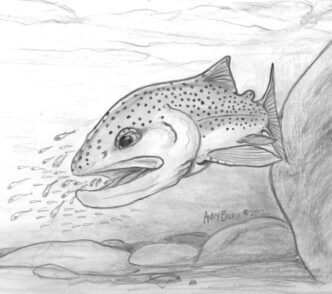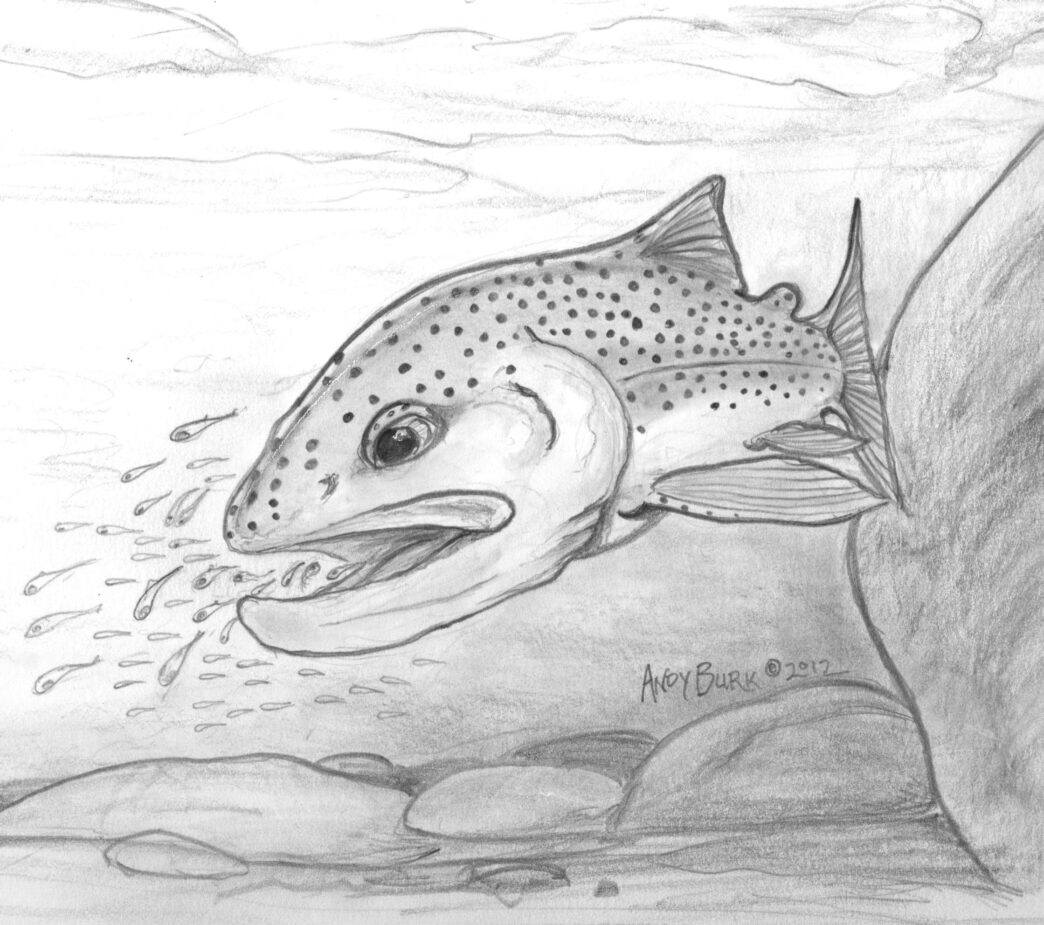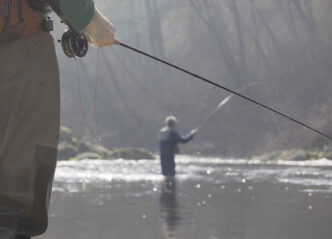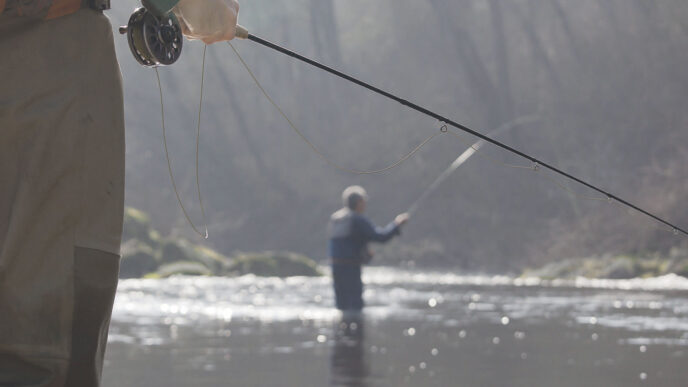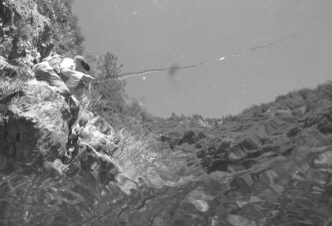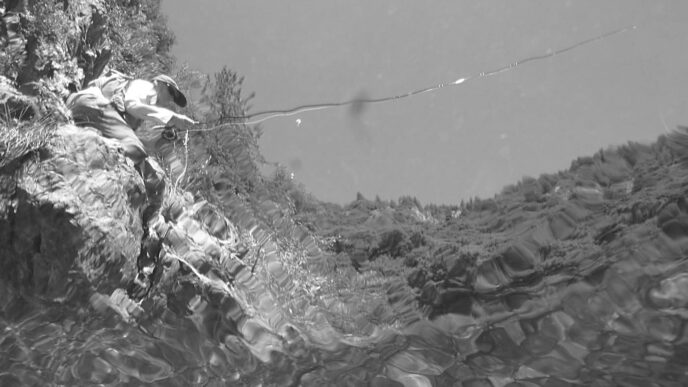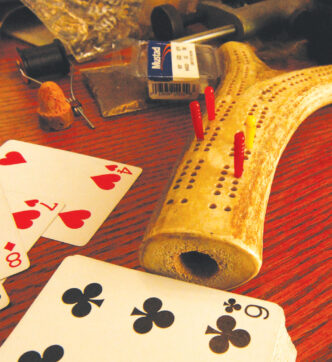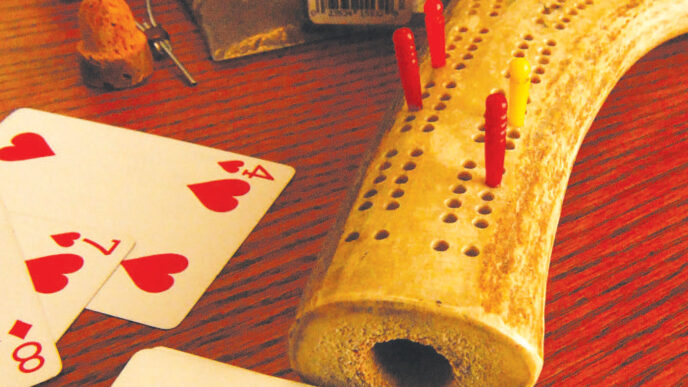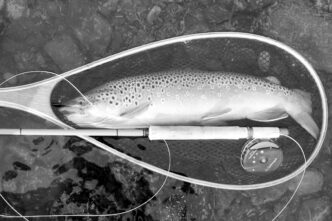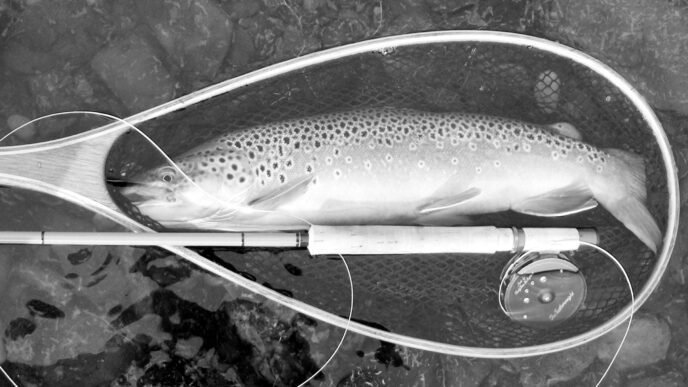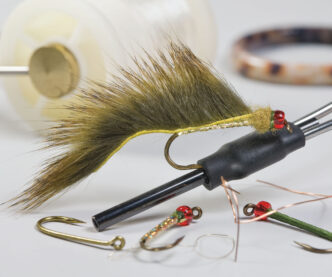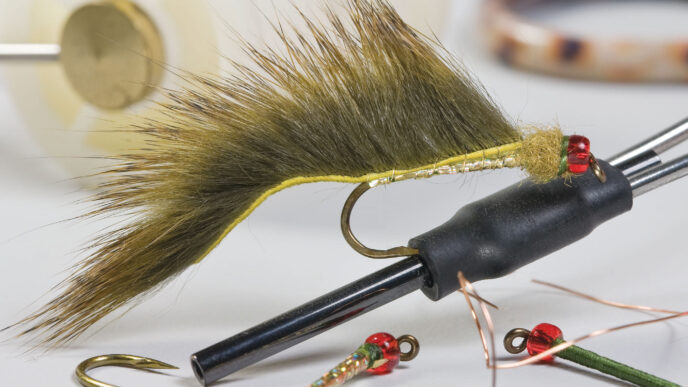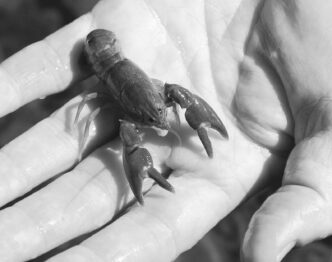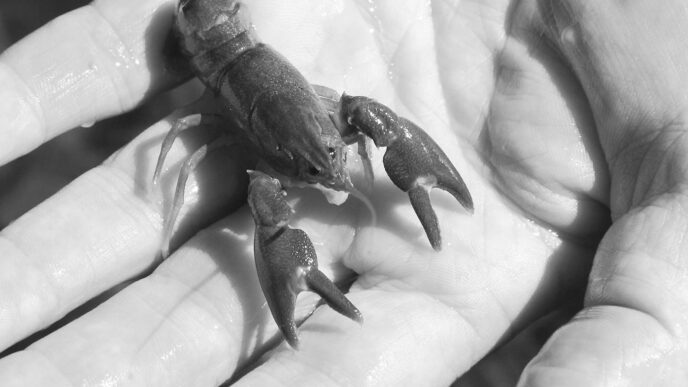“Hey Andy, check this out,” said my pal Barrett as he dropped the giant fly in my hand. I don’t remember if my eyes bugged out when I saw it, but I’m pretty sure I looked shocked. The fly was almost eight inches long! That wouldn’t surprise me if we were in the Delta, or on a bass pond, or at the coast, but we were standing on a trout stream that is 50 feet across in the wide spots.
I started to laugh, and then he pulled out the picture. I stared at the photo of a brown trout that looked to be well over two feet long, and dangling from its mouth was the same giant streamer that rested in the palm of my hand. A quick look across the river at a large boulder told me that the picture I held wasn’t taken far from the spot where we were standing. I quickly tucked the fly away, pulled out my box of streamers, and handed it to Barrett. When he opened the box, a broad smile crossed his face, and he laughed softly. The box I had handed him was full of streamers imitating baitfish, as his did, but most of them were under an inch and half long, and a fair share were only an inch long or even shorter.
“I know you’re fishing these, because you’ve got a lot of ’em,” Barrett said, and then added, “Tell me more.” He and I have fished together quite a bit, and we always seem to end up trading flies and ideas. I showed him a five-inch-long streamer a couple years back, and he has refined his tying of these oversize flies to the point of near perfection. It’s always nice to come across a real student of fly tying, and I always try to get a sample of one of Barrett’s flies anytime I can. I’ve noticed that he has the same strategy when he looks at my fly boxes. So I explained to him a bit about my itty-bitty baitfish imitations.
A few years back, I was having a poor run of luck on the Truckee and was trying to change my fortunes. It had been another rough morning, and I had only one small brown trout to show for my efforts when I stopped to grab a drink and a slightly crushed sandwich from my backpack. Sitting atop a boulder at the river’s edge, as I ate the sandwich, I began to reflect on the abysmal fishing I’d had so far that day. As I wondered what the heck I was going to do to change things, a large chunk of my sandwich fell into the water. While cursing this further example of my bad luck (it was a really good sandwich), I noticed that a school of tiny baitfish had converged on the sinking remains of the better part of my lunch. I studied them closely. “What are these little fish?” I wondered. “Very young trout? Whitefish? Lahontan redsides? What the heck could they be?”
I searched my pack and discovered that the aquarium net that I usually use to sample bugs from the stream had gone missing, I knew from previous experience that trying to catch wee bitty baitfish by hand is an exercise in futility. I also have fished the Truckee for long enough to recognize a bonanza of a food source for the trout that live there when I see it. So I got as close as I could to the water and stared at the little fish. They looked to be whitefish or possibly sticklebacks. Prominent, bulgy eyes and a slender body with a transparent silvery-olive coloration were pretty much all I had to go on.
I started prowling through my fly boxes, searching for something vaguely similar in size, shape, and color. I found a few likely candidates in my nymph box and with a little scissors work and selective pruning, I soon had a couple of flies that looked kind of like the little fish with which I had shared my sandwich. Now all I had to do was figure out how to present them to greatest effect.
My rod was rigged with my usual floating line and a 9-foot leader that ended with 2 feet of 5X tippet. I tied on one of my modified microstreamers, which had begun its life as a caddis pupa, and decided to try fishing it like a traditional streamer, starting with a slightly up-and-across stream cast. I retrieved the fly with short, inch-long jerks, trying to keep in mind that I had to consider the physical capabilities of the actual baitfish. These little guys move in nervous little fits and starts. I needed to remember this and not rip the streamer across the stream, as I would with other flies imitating larger, more mobile baitfish.
It took a few minutes of watching the little fly react to my animations to perfect a swimming action that I thought looked pretty convincing, to my eye anyway. I had worked down the bank a little ways when I saw a large boulder with a pocket of shade along the near side. I used an upstream reach cast, placing the fly a couple of feet up from the boulder, and fed a little line into the drift to allow the fly to sink into the shady pocket. Just as I was about to begin my retrieve I saw a silvery flash at the edge of the shade. I pulled back, setting the hook with as light a touch as I could muster, and was soon connected to a fat little rainbow. In the meshes of the net, it glistened and sparkled in the afternoon light as only a wild trout can. I slipped the hook from its lip and watched it dart away into the safety of the depths.
When I returned my attention to the boulder, tossing another cast almost identical to the first, I wasn’t expecting a fish, because I’d just caught one, but there it was. A sharp tug, a brief tussle, and a second fish almost a twin of the first lay captured in my net. After another quick release, though, I was struck by a vague twinge of doubt. Maybe they were just taking my modified microstreamer because it just looked like food. I thought about how many times I had fished caddis pupa imitations and soft hackles in exactly the same manner and had caught plenty of fish doing it. It was obvious that I needed to put a different twist on this to convince myself that they were taking the fly for a small baitfish. I looked upstream and thought that the long, bouldery stretch of pocket water looked like an inviting place to test my microstreamers further.
I molded a tiny glob of tungsten putty onto my tippet a few feet above my fly and started sneaking my way up the bank, making short casts upstream to any spot that looked like it had the remotest possibility of holding a fish. Ralph Cutter taught me about fishing streamers by retrieving them downstream years ago, and I’ve employed his lessons to great effect on many waters since then. I kept this in mind as I fished my way upstream.
Making short casts with immediate line control, I swept the rod downstream, twitching it along like a disoriented little fish struggling in the current — not at all the way a caddis pupa, for example, would behave. The responses from the fish were immediate, sometimes bordering on violent. I lost quite a few fish — they just wouldn’t stay on the end of my line. It was frustrating, for sure, but at the very same time too much fun too pass up. As the day started to fade, I decided it was time to head home for a fly-tying session and more thought about imitating little baitfish.
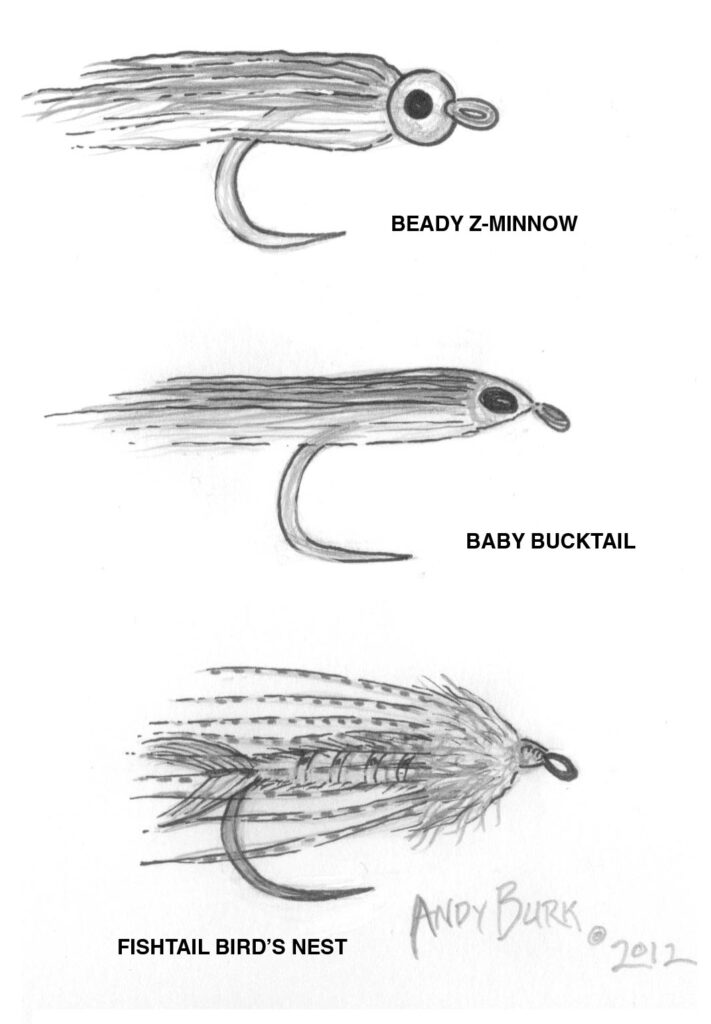
As I sat at the vise surrounded by a disarray of fly tying materials, I stared for a few moments at a hank of olive Z-Lon that looked close to the color that I thought the little fish that ate my sandwich had been. I wanted to make the pattern fairly simple, because it seemed like I might end up losing a lot of these flies. A couple of hours later, I had a pile of experimental patterns to fill a couple of rows in my fly boxes.
Returning to the river the next day, I immediately put my new creations to use. As always, the rejects outnumbered the winners, but I soon found a few consistent producers, and with a little further refinement, they have become a regular choice in both moving and still waters. Microstreamers really work.
After a few months of fishing, I began to explore tying scaled-down versions of traditional streamers and then little microcrayfish streamers and minisculpins. They all seemed to work, and they were simple flies to tie, compared with some of the bigger streamers that I love to fish. They will probably never replace my favorite big articulated rainbow trout flies in the adrenaline-rush category as far as the size of fish that are caught on them is concerned, but they will take big fish as well as little ones. When a two-footer chases down a microstreamer in pocket water for the first time, it’ll stop your heart.
Microstreamer Tying Notes
It is crucial to keep these microstreamers sparse and simple — it makes leaving them in trees and on rocks and other stream obstructions less painful. You can immediately see the value of small beads to imitate the bulgy heads and prominent eyes of little baitfish. I like to add a simple eye to my beadheads using a small dowel and acrylic paint. This easy addition makes the fly look more realistic in the water and tones down the flash of the beadhead. The eye markings don’t last for long when you’re fishing these flies hard, but they are well worth the minimal effort required to add to the flies’ fish appeal. I seldom use tungsten beads for these flies, because they sink too quickly in the shallower water that the little fish inhabit. Apply all the other materials very sparsely. Less is more when imitating very delicate and transparent tiny baitfish. If you add flash to these little flies, use it just one strand at a time, rather than in a flashy clump. Rely on the natural trans-lucence of your materials to provide a lifelike effect.
Don’t be afraid to experiment. These flies are easily modified, and I expect you’ll come up with all kinds of interesting variations.
BEADY Z-MINNOW
Hook: Tiemco 2488, size 12 to 16
Bead: Nickel finish, sized to hook
Thread: White Ultrathread, 70 denier
Belly: Light gray Z-Lon
Back: Olive Z-Lon
BABY BUCKTAIL
Hook: Standard-length wet-fly hook, size 12 to 16
Thread: White Ultrathread, 70 denier
Midwing: Olive brown Z-Lon
Belly: White bucktail, very sparse, 8 to 11 strands. Use the very finest fibers, which are located at the top of the bucktail, for the best results, or experiment with other fine-fibered hairs.
Top wing: Olive bucktail, very sparse, 8 to 11 strands
Head: Apply a small pupil with acrylic paint and coat the finished fly’s head with glossy-finish head cement
FISHTAIL BIRD’S NEST
Hook: 2X-long standard nymph hook, size 12 to 16
Thread: White, 70 denier
Tail: Hen neck feather, notched with scissors (see illustration)
Ribbing: Pearl Krystal Flash
Abdomen: Pale creamy olive dubbing blend (make your own for the best results)
Hackle: Mallard flank, natural color
Head: Pale olive dubbing blend, tied shaggy and full. Again, make your own dubbing blend.
The Fishtail Bird’s Nest begs to have a beadhead version, as well. Just add a small black or silver bead to the hook before tying. Otherwise leave this one unweighted. That’s the way that Cal Bird, creator of the Bird’s Nest, tied most of the Bird’s Nests that came from his vise.
Take a look the next time you’re out on the water and notice how many times you see schools of little baitfish milling around in areas where they can be preyed upon by the larger denizens of the river or lake. Just don’t let the little fish eat your sandwich!



